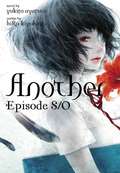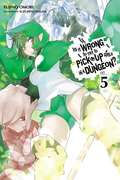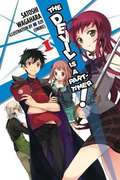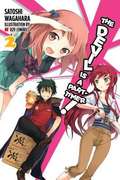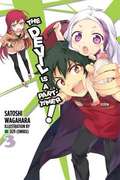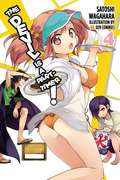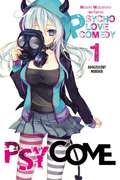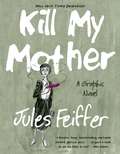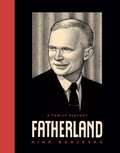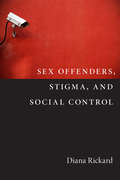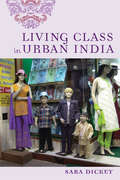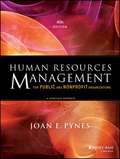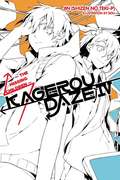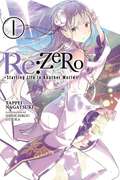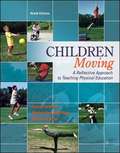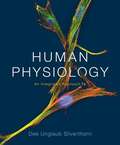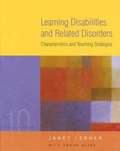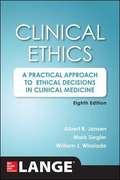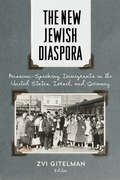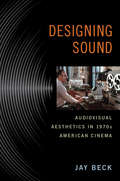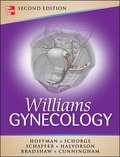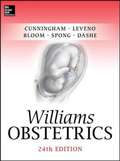- Table View
- List View
Another Episode S / 0
by Yukito Ayatsuji Hiro KiyoharaSummer, 1998. Mei Misaki, age fifteen, has gone with her family to their seaside vacation home. There she meets the ghost of Teruya Sakaki, her classmate from Yomiyama North Middle School Class 3-3 who, like Mei, witnessed the mysterious events that had transpired at the school. There begins an adventure of memory and mystery as they search for the ghost's body and his memories alike.
Is It Wrong to Try to Pick Up Girls in a Dungeon?, Vol. 5
by Fujino Omori Suzuhito YasudaBell, along with his adventuring party of Welf the swordsmith and Lilly the supporter, has made it into the middle floors of the Dungeon, but the schemes of another party have stranded them there! Hestia's going to need to send help, but will the rescuers arrive in time to save Bell and his friends from the monster that's got them cornered? The familia myth of the boy and the goddess continues!
The Devil Is a Part-Timer!, Vol. 1
by Satoshi Wagahara 029Do you want fries with your hellfire? Being soundly thrashed by the hero Emilia, the Devil King and his general beat a hasty retreat to a parallel universe...only to land smack in the middle of bustling, modern-day Tokyo! Lacking the magic necessary to return home, the two are forced to assume human identities and live average human lives until they can find a better solution. And to make ends meet, Satan finds gainful employment at a nearby fast food joint! With his devilish mind set on working his way up the management food chain, what will become of his thirst for conquest?!
The Devil Is a Part-Timer!, Vol. 2
by Satoshi Wagahara 029Do you want fries with your hellfire? Sadao Maou, the Devil King, has finally been promoted to store manager! And who should move in next door to his fortress (actually a tiny studio apartment in a dingy walk-up) but a lovely kimono-wearing lass. But the former devil-crushing hero Emi Yusa is none too pleased with this turn of events, to say nothing of high schooler Chiho Sasaki, who's still nursing a terrible crush on the Devil King. Meanwhile a Sentucky Fried Chicken has opened up right across the street from Maou's beloved MgRonald! It's the first real test of his managerial prowess, and he's facing a pay cut unless he can top Sentucky's sales! Between the two new neighbors, the Devil King's troubles are anything but part-time!
The Devil Is a Part-Timer!, Vol. 3
by Satoshi Wagahara 029Do you want fries with your hellfire? A portal opens in the courtyard of the Devil's Castle (a tiny walk-up). From it emerges a little girl who calls the Devil King "papa" and the Hero "mama." Ashiya and Chiho are shocked to discover that Maou and Emi had that kind of relationship, but nobody's more surprised than the two new "parents." Will Maou the breadwinner be able to make the grade when it comes to child rearing? And will this spell the end of the starry-eyed Emi's romantic ambitions?
The Devil Is a Part-Timer!, Vol. 4
by 029 Satoshi WagaharaWith his beloved MgRonald closed for renovations, the Devil King's out of work! Worse, the apartment he shares at Villa Rosa Sasazuka has gotten damaged thanks to his fight with Gabriel, which means the household has to temporarily vacate the premises. Having lost both his title and his vast land holdings, the Devil King takes a part-time job at his landlady's niece's beach house--and of course Chiho and Emi insist on coming along. It's summertime at the beach, but the Devil's still got work to do...!
Psycome, Vol. 1: Murderer in the Flower of Death
by Namanie Mizuki MizushiroAccused of a crime he didn't commit, Kyosuke Kamiya is sent to Purgatorium Rehabilitation Academy. Suddenly, he's surrounded by a variety of fetching lasses--each one a murderer! Worse, he's famous for being the "Dozen Demon," a killer responsible for twelve deaths! When the busty, gas mask-wearing beauty Renko Hikawa approaches him, the difference between death and desire becomes very narrow indeed. How is Kyosuke gonna graduate alive?
Kill My Mother: A Graphic Novel
by Jules FeifferA Vanity Fair Best Book of 2014. A Kirkus Reviews Best Fiction Book of 2014. When three daunting dolls intersect with one hapless heroine and a hard-boiled private eye, deception, betrayal, and murder stalk every mean street in...Kill My Mother.<P><P> Adding to a legendary career that includes a Pulitzer Prize, an Academy Award, Obie Awards, and Lifetime Achievement Awards from the National Cartoonist Society and the Writers Guild of America, Jules Feiffer now presents his first noir graphic novel. Kill My Mother is a loving homage to the pulp-inspired films and comic strips of his youth. Channeling Eisner's The Spirit, along with the likes of Hammett, Chandler, Cain, John Huston, and Billy Wilder, and spiced with the deft humor for which Feiffer is renowned, Kill My Mother centers on five formidable women from two unrelated families, linked fatefully and fatally by a has-been, hard-drinking private detective.<P><P> As our story begins, we meet Annie Hannigan, an out-of-control teenager, jitterbugging in the 1930s. Annie dreams of offing her mother, Elsie, whom she blames for abandoning her for a job soon after her husband, a cop, is shot and killed. Now, employed by her husband's best friend--an over-the-hill and perpetually soused private eye--Elsie finds herself covering up his missteps as she is drawn into a case of a mysterious client, who leads her into a decade-long drama of deception and dual identities sprawling from the Depression era to World War II Hollywood and the jungles of the South Pacific.<P><P> Along with three femme fatales, an obsessed daughter, and a loner heroine, Kill My Mother features a fighter turned tap dancer, a small-time thug who dreams of being a hit man, a name-dropping cab driver, a communist liquor store owner, and a hunky movie star with a mind-boggling secret. Culminating in a U.S.O. tour on a war-torn Pacific island, this disparate band of old enemies congregate to settle scores.<P> In a drawing style derived from Steve Canyon and The Spirit, Feiffer combines his long-honed skills as cartoonist, playwright, and screenwriter to draw us into this seductively menacing world where streets are black with soot and rain, and base motives and betrayal are served on the rocks in bars unsafe to enter. Bluesy, fast-moving, and funny, Kill My Mother is a trip to Hammett-Chandler-Cain Land: a noir-graphic novel like the movies they don't make anymore.<P><P> <i>Advisory: Bookshare has learned that this book offers only partial accessibility. We have kept it in the collection because it is useful for some of our members. Benetech is actively working on projects to improve accessibility issues such as these.</i>
Fatherland: A Family History
by Nina Bunjevac"A heartfelt and extremely absorbing examination of exile, reconciliation and destructive politics...as vividly immediate as any headline." --Rachel Cooke, Guardian Standing alongside Marjane Satrapi's Persepolis and Joe Sacco's Palestine, Nina Bunjevac's Fatherland renders the searing history of the Balkans in the twentieth century through the experiences of the author and her family. In 1975, fearing her husband's growing fanaticism, Nina Bunjevac's mother fled her marriage and adopted country of Canada, taking Nina--then only a toddler--and her older sister back to Yugoslavia to live with her parents. Her husband and Nina's father, Peter, was a die-hard Serbian nationalist who was forced to leave his country in the 1950s. Remaining in Canada, he became involved with a terrorist organization bent on overthrowing the Communist Yugoslav government and attacking its supporters in North America. Then in 1977, while his family was still in Yugoslovia, Peter was killed in an accidental explosion while building a bomb. Through exquisite and haunting black-and-white art, Nina Bunjevac documents the immediate circumstances surrounding her father's death and provides a sweeping account of the former Yugoslovia under Fascism and Communism, telling an unforgettable true story of how the scars of history are borne by family and nation alike.
Sex Offenders, Stigma, and Social Control
by Diana RickardThe 1990s witnessed a flurry of legislative initiatives--most notably, "Megan's Law"--designed to control a population of sex offenders (child abusers) widely reviled as sick, evil, and incurable. In Sex Offenders, Stigma, and Social Control, Diana Rickard provides the reader with an in-depth view of six such men, exploring how they manage to cope with their highly stigmatized role as social outcasts. The six men discussed in the book are typical convicted sex offenders--neither serial pedophiles nor individuals convicted of the type of brutal act that looms large in public perceptions about sex crimes. Sex Offenders, Stigma, and Social Control explores how these individuals, who have been cast as social pariahs, construct their sense of self. How does being labeled in this way and controlled by measures such as Megan's Law affect one's identity and sense of social being? Unlike traditional criminological and psychological studies of this population, this book frames their experiences in concepts of both deviance and identity, asking how men so highly stigmatized cope with the most extreme form of social marginality. Placing their stories within the context of the current culture of mass incarceration and zero-tolerance, Rickard provides a deeper understanding of the complex relationship between public policy and lived experience, as well as an understanding of the social challenges faced by this population, whose re-integration into society is far from simple or assured. Sex Offenders, Stigma, and Social Control makes a significant contribution to our understanding of sex offenders, offering a unique window into how individuals make meaning out of their experiences and present a viable--not monstrous--social self to themselves and others.
Living Class in Urban India
by Sara DickeyMany Americans still envision India as rigidly caste-bound, locked in traditions that inhibit social mobility. In reality, class mobility has long been an ideal, and today globalization is radically transforming how India's citizens perceive class. Living Class in Urban India examines a nation in flux, bombarded with media images of middle-class consumers, while navigating the currents of late capitalism and the surges of inequality they can produce. Anthropologist Sara Dickey puts a human face on the issue of class in India, introducing four people who live in the "second-tier" city of Madurai: an auto-rickshaw driver, a graphic designer, a teacher of high-status English, and a domestic worker. Drawing from over thirty years of fieldwork, she considers how class is determined by both subjective perceptions and objective conditions, documenting Madurai residents' palpable day-to-day experiences of class while also tracking their long-term impacts. By analyzing the intertwined symbolic and economic importance of phenomena like wedding ceremonies, religious practices, philanthropy, and loan arrangements, Dickey's study reveals the material consequences of local class identities. Simultaneously, this gracefully written book highlights the poignant drive for dignity in the face of moralizing class stereotypes. Through extensive interviews, Dickey scrutinizes the idioms and commonplaces used by residents to justify class inequality and, occasionally, to subvert it. Along the way, Living Class in Urban India reveals the myriad ways that class status is interpreted and performed, embedded in everything from cell phone usage to religious worship.
Guide to Analysis of Language Transcripts
by Kristine S. RetherfordGuide to Analysis of Language Transcripts is now in its third edition This updated text is more reader-friendly and includes analysis practice on CD-ROM, too. Through the use of this comprehensive text readers learn classic semantic, syntactic, and pragmatic analysis. The opening chapter thoroughly explains the collection and transcription of conversation speech samples. The GALT presents hundreds of helpful example utterances (with full explanations) plus four transcriptions for analysis.
Human Resources Management For Public And Nonprofit Organizations: A Strategic Approach
by Joan E. PynesSince the first edition was published in 1997, Human Resources Management for Public and Nonprofit Organizations has become the go-to reference for public and nonprofit human resources professionals. Now in its fourth edition, the text has been significantly revised and updated to include information that reflects changes in the field due to the economic crisis, changes in federal employment laws, how shifting demographics affect human resources management, the increased use of technology in human resources management practices, how social media has become embedded in the workplace, and new approaches to HRM policy and practice. Written by Joan E. Pynes--a noted expert in public administration--this authoritative work shows how strategic human resources management is essential for managing change in an increasingly complex environment. The book Includes new material on workplace violence and employee discipline.
Kagerou Daze, Vol. 4: The Missing Children
by Jin SiduA certain boy and girl meet on a certain endless summer day. They thought they were alone, misunderstood by everyone, but the powers they hold in their eyes lead them to a group that does understand them: the Mekakushi-dan. They're not alone anymore, but now they have a new mystery to solve: What is the phenomenon of the "kagerou daze," and who is the shadowy figure behind it?
Re:ZERO -Starting Life in Another World-, Vol. 1
by Tappei Nagatsuki Shinichirou OtsukaSubaru Natsuki was just trying to get to the convenience store but wound up summoned to another world. He encounters the usual things--life-threatening situations, silver haired beauties, cat fairies--you know, normal stuff. All that would be bad enough, but he's also gained the most inconvenient magical ability of all--time travel, but he's got to die to use it. How do you repay someone who saved your life when all you can do is die?
Children Moving: A Reflective Approach to Teaching Physical Education
by George Graham Shirley Ann Holt/Hale Melissa ParkerThe authors of Children Moving, however, recognize that each child is unique. One size does not fit all! Thus, Children Moving guides you in the process of learning to teach a curriculum that is differentiated for a range of skill abilities and fitness levels. If all children were the same, we would be able to package a curriculum with the same games and the same gymnastic stunts and dances you would do with all of the children as if they were identical. Children Moving, on the other hand, introduces you to the reflective approach--a process of teaching that provides the background for you to adapt, adjust, and modify lessons so they are interesting and worthwhile for all of the children you teach--from the lowest to the highest skill and fitness levels. The ultimate goal, of course, is to guide youngsters in the process of becoming physically active for a lifetime.
Linguistics for Educators: A Practical Guide Second Edition with Exercises
by Steven Landon WestA practical guide for Linguistics for Educators
Human Physiology: An Integrated Approach
by Dee Unglaub SilverthornHuman Physiology: An Integrated Approach has thorough coverage of molecular physiology seamlessly integrated into a traditional homeostasis-based systems approach.
Learning Disabilities and Related Disorders: Characteristics and Teaching Strategies
by Janet W. Lerner Frank KlineDesigned to help pre-service teachers and practicing professionals evaluate and aid students with disabilities, this comprehensive text is guided by three main principles: to aid in the assessment and evaluation of students with learning disabilities, to demonstrate Learning Disabled (LD) theory and its practical applications through the use of case studies, and to provide the most up-to-date information on recent developments and topics of debate in the field. The Tenth Edition continues to stress familiarity with state and national standards, specifically those from the Council for Exceptional Children (CEC).
Clinical Ethics: A Practical Approach to Ethical Decisions in Clinical Medicine
by Albert R. Jonsen Mark Siegler William J. WinsladeTrust the proven "Four Box" method to formulate ethically appropriate recommendations for patient care. Clinical Ethics teaches healthcare providers how to effectively identify, evaluate, and resolve ethical issues in clinical medicine. Using the author acclaimed "Four Box Method" and numerous illustrative case examples, this book enables practitioners to gain a better understanding of the complexities involved in ethical cases and demonstrates how to reach resolution to ethical problems. Clinical Ethics goes beyond theory to offer a decision-making strategy applicable to real-world practice. Readers will learn an easy-to-apply system based on simple questions about medical indications, patient preferences, quality of life, and contextual features that clearly explain clinical ethics and help them formulate a sound diagnosis and treatment strategy. The case examples have been selected to demonstrate how principles apply to real-world everyday practice. The co-authors, a bioethicist, a physician and a lawyer/ psychoanalyst /philosopher, draw on more than forty years respectively of clinical experience to select exemplary cases of ethical problems and to reflect on how moral principles and concepts can guide clinicians in formulating ethically appropriate recommendations for patient care. A unique chapter organization: Each chapter of the book begins with some general considerations about the topic, and the ethical principle relevant to that topic. The clinical situations that generate ethical problems are then described and illustrated by clinically realistic medical cases. A short distillation of current opinion from the bioethical literature is provided, followed by an analysis of the cases. . The authors conclude with recommendations that the three authors have formulated from their extensive experience as bioethics consultants.
The New Jewish Diaspora: Russian-Speaking Immigrants in the United States, Israel, and Germany
by Sveta Roberman Uzi Rebhun Jonathan Dekel-Chen Adrian Wanner Nelly Elias Mikhail Krutikov Steven J. Gold Mark Tolts Hannah Pollin-Galay Julia Lerner Marina Sapritsky Zvi Gitelman Elena Nosenko-Shtein Olena Bagno-Moldavski Stephanie Sandler Anna Shternshis Eliezer Ben-Rafael Gur Ofer Yaacov Ro'IIn 1900 over five million Jews lived in the Russian empire; today, there are four times as many Russian-speaking Jews residing outside the former Soviet Union than there are in that region. The New Jewish Diaspora is the first English-language study of the Russian-speaking Jewish diaspora. This migration has made deep marks on the social, cultural, and political terrain of many countries, in particular the United States, Israel, and Germany. The contributors examine the varied ways these immigrants have adapted to new environments, while identifying the common cultural bonds that continue to unite them. Assembling an international array of experts on the Soviet and post-Soviet Jewish diaspora, the book makes room for a wide range of scholarly approaches, allowing readers to appreciate the significance of this migration from many different angles. Some chapters offer data-driven analyses that seek to quantify the impact Russian-speaking Jewish populations are making in their adoptive countries and their adaptations there. Others take a more ethnographic approach, using interviews and observations to determine how these immigrants integrate their old traditions and affiliations into their new identities. Further chapters examine how, despite the oceans separating them, members of this diaspora form imagined communities within cyberspace and through literature, enabling them to keep their shared culture alive. Above all, the scholars in The New Jewish Diaspora place the migration of Russian-speaking Jews in its historical and social contexts, showing where it fits within the larger historic saga of the Jewish diaspora, exploring its dynamic engagement with the contemporary world, and pointing to future paths these immigrants and their descendants might follow.
Jewish Mad Men: Advertising and the Design of the American Jewish Experience
by Professor Kerri P. SteinbergIt is easy to dismiss advertising as simply the background chatter of modern life, often annoying, sometimes hilarious, and ultimately meaningless. But Kerri P. Steinberg argues that a careful study of the history of advertising can reveal a wealth of insight into a culture. In Jewish Mad Men, Steinberg looks specifically at how advertising helped shape the evolution of American Jewish life and culture over the past one hundred years. Drawing on case studies of famous advertising campaigns--from Levy's Rye Bread ("You don't have to be Jewish to love Levy's") to Hebrew National hot dogs ("We answer to a higher authority")--Steinberg examines advertisements from the late nineteenth-century in New York, the center of advertising in the United States, to trace changes in Jewish life there and across the entire country. She looks at ads aimed at the immigrant population, at suburbanites in midcentury, and at hipster and post-denominational Jews today. In addition to discussing campaigns for everything from Manischewitz wine to matzoh, Jewish Mad Men also portrays the legendary Jewish figures in advertising--like Albert Lasker and Bill Bernbach--and lesser known "Mad Men" like Joseph Jacobs, whose pioneering agency created the brilliantly successful Maxwell House Coffee Haggadah. Throughout, Steinberg uses the lens of advertising to illuminate the Jewish trajectory from outsider to insider, and the related arc of immigration, acculturation, upward mobility, and suburbanization.Anchored in the illustrations, photographs, jingles, and taglines of advertising, Jewish Mad Men features a dozen color advertisements and many black-and-white images. Lively and insightful, this book offers a unique look at both advertising and Jewish life in the United States.
Designing Sound: Audiovisual Aesthetics in 1970s American Cinema
by Jay BeckThe late 1960s and 1970s are widely recognized as a golden age for American film, as directors like Francis Ford Coppola, George Lucas, and Martin Scorsese expanded the Hollywood model with aesthetically innovative works. As this groundbreaking new study reveals, those filmmakers were blessed with more than just visionary eyes; Designing Sound focuses on how those filmmakers also had keen ears that enabled them to perceive new possibilities for cinematic sound design. Offering detailed case studies of key films and filmmakers, Jay Beck explores how sound design was central to the era's experimentation with new modes of cinematic storytelling. He demonstrates how sound was key to many directors' signature aesthetics, from the overlapping dialogue that contributes to Robert Altman's naturalism to the wordless interludes at the heart of Terrence Malick's lyricism. Yet the book also examines sound design as a collaborative process, one where certain key directors ceded authority to sound technicians who offered significant creative input. Designing Sound provides readers with a fresh take on a much-studied era in American film, giving a new appreciation of how artistry emerged from a period of rapid industrial and technological change. Filled with rich behind-the-scenes details, the book vividly conveys how sound practices developed by 1970s filmmakers changed the course of American cinema.
Williams Gynecology, Second Edition
by Barbara L. Hoffman John O. Schorge Joseph I. Schaffer Lisa M. Halvorson Karen D. Bradshaw F. Gary Cunningham Lewis E. CalverWilliams Gynecology provides a thorough presentation of gynecology's depth and breadth. In Section 1, general gynecology topics are covered. Sections 2 provides chapters covering reproductive endocrinology and infertility. The developing field of Female Pelvic Medicine and Reconstructive Surgery is presented in Section 3. In Section 4, gynecologic oncology is discussed.
Williams Obstetrics, Twenty-Fourth Edition
by F. Gary Cunningham Kenneth J. Leveno Steven L. Bloom Catherine Y. Spong Jodi S. Dashe Barbara L. Hoffman Brian M. Casey Jeanne S. SheffieldWilliams Obstetrics is the most detailed, comprehensive, and rigorously referenced text on the subject. Written by an author team from the world-renowned Parkland Hospital, the hallmarks of this classic are its thoroughness, scientific basis, and practical applicability for the obstetrician at the bedside. This edition of Williams Obstetrics continues to emphasize the scientific-based underpinnings and evidence-based practices of the specialty. This is accomplished by using incorporating more than 3,000 new literature citations and guidelines from the most trusted professional and academic organizations.
